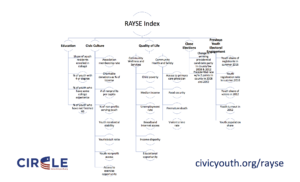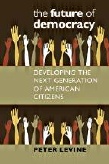A strong civic life depends on ALL, not just some, youth participating. The RAYSE Index (Reaching All Youth Strengthens Engagement) embodies CIRCLE’s vision that research data can and should enhance the quantity, equality, and impact of youth civic engagement. The RAYSE Index is designed to facilitate program and outreach investment decisions (time, money, or people) at the county level.
The RAYSE Index is a great tool and framework for thinking about civic health and a way to start conversations about the strengths and assets of a community for civic engagement. The Index should always be used with other forms of knowledge about existing youth leadership and civic capacities.
To find out about opportunities to learn more about how to use the RAYSE Index, opportunities to discuss the data and more, sign up here.
What is the RAYSE Index? | Why a RAYSE Index? | Uses of the RAYSE Index
What to Add to RAYSE | Methodology | Contact Us & Technical Assistance
What Is the RAYSE Index?
We believe research and data can play a role in increasing the quantity, quality, and impact of youth engagement in solving urgent problems in their communities. However, available data on youth engagement is often national or, at best, state-level, while conditions on the ground can vary widely within states and localities. The RAYSE Index is designed to inform program and outreach investment decisions (e.g. time, money, or people), as well as storytelling for outreach and fundraising purposes, at the county level by combining youth-relevant demographic and civic-related data. It allows organizations to access research insights that point to where, and in what ways, specific communities can increase opportunities for youth civic engagement.
RAYSE provides data by county on factors and conditions that we know correlate with civic engagement beyond voting. County conditions in each of the five areas are labeled as high, moderate, or low potential to support an increase in youth civic engagement. The star rating illustrates how we estimate the degree to which these conditions together can raise youth civic engagement. Instead of providing a single ranking, users can tailor the county list by filtering for desired priorities (e.g. location, youth subgroup, political history).
To build the RAYSE Index, CIRCLE staff created a framework based on what research has been shown to support or correlate with youth civic engagement. These influencing factors were then organized into categories that informed our search for corresponding, available, and reliable datasets. County-level data exists for many of the factors but not all. In the end, the RAYSE Index was built using several large datasets (see list here), many of them using federal data (e.g. IRS, Census). Each column is a statistical summary of factors (index).

Why a Rayse Index?
All youth deserve to have a voice on issues that matter to them. Unfortunately, research continues to show that this ideal is not achieved for millions of young people.
CIRCLE is committed to helping organizations and governments use research and data to improve civic life and close gaps in opportunities for civic engagement. In a democracy, any amount of systemic inequity is too much. In many areas young people face profoundly unequal opportunities. Young people report different levels of access to youth organizations, to regular high speed internet and mobile reception, as well as varied perceptions of whether their voice matters and whether people want to hear it. Unfortunately, k-12 school systems can also add to and create further gaps in “civic empowerment” that can set back community-based efforts.
The RAYSE Index brings data to bear on efforts to broaden access to youth engagement opportunities. The comparative county-level data can provide research-based support for making the case that engagement has a high potential for growth and for making decisions about where to invest resources.
Uses of the RAYSE Index
Identifying Growth Areas
National civic organizations, political campaigns, and grantmaking organizations may be looking to strategically invest in new areas or emerging efforts in order to maximize resources in a location where youth engagement can grow.
Distributing Scarce Resources
At the national or state level, those interested in youth engagement often do not have the funding to match their ambitions. As a result, difficult choices about how and where to distribute funding to support efforts are required. The RAYSE Index can provide data to inform those decisions.
Building on Community Strengths and Challenges
Whether or not resources—networks, capacity, funding—are scarce, the RAYSE Index can also be used to look at where counties in a state, region, or nationwide have high and low existing conditions. For example, a county with strong civic culture may leverage that to increase youth engagement, while a county with low youth influence on elections could leverage voter registration to improve in that area.
Justification/Building your Case
Finally, research and data are often used for advocacy and resource development. For organizations that work in one or a small number of counties, the RAYSE Index can serve as a data source for storytelling about why that area specifically may need investment (and in a future iteration of the RAYSE Index, specific measures to cite!).
What to do Next with RAYSE: Bringing in Supplemental Information
As we state at the beginning, the RAYSE Index is a great tool and framework for thinking about civic health and a way to start conversations about how to best utilize a community’s assets for increasing and expanding civic engagement for all youth. The Index should always be used with other forms of knowledge about existing youth leadership, civic capacities, and infrastructure, by which we mean the existing local processes, resources, spaces, and networks in some way contributing to community members’ ability to discuss and act on issues they care about.
What information is important to supplement RAYSE with will depend on your goals and positioning.
- Regardless, we suggest understanding what existing practitioner groups may be working on in the area related to your goals or issue.
- One component of understanding existing civic efforts may also be understanding salient local issues, any recent ballot initiatives, and whether local elections are competitive.
- Additionally, while part of our original theoretical model, we were not able to find updated, comprehensive county-level data on social connections between people, school discipline, social media usage, presence and importance of religious congregations, and media outlets.
- While engagement is affected by national social media conversations and national outlets/sites, localities can differ greatly in terms of how much people use social media for local civic conversations, how much information is around about civic issues (and where it comes from), etc.
- Local knowledge about the towns and cities within a county can also contribute to understanding how civic engagement opportunities are impacted by the school curriculum, availability of funding for things like youth internships and summer jobs, and municipal rules and ordinances related to citizen participation (e.g., participatory budgeting). These opportunities can vary greatly from community to community within a county.
- Finally, to gain a full picture of assets and challenges, it is valuable to understand state policy as it relates to your issue area, voting and voter registration, and civic education. The latter two can affect communities differently, and investigating the policy and local implementation can provide insights about whether the policies inhibit or can help engagement.
Methodology
Summary of RAYSE Theory
One way to define a community’s civic health is the frequency and means by which residents address shared challenges and strive to improve quality of life. Research has repeatedly shown that several factors are linked to more civic engagement, and the more people are engaged, the better civic health a community has. In turn, communities with better civic health have been found to be more resilient against economic stress (Kawashima-Ginsberg, Lim & Levine, 2012), and individual civic engagement is associated with a host of positive outcomes like employment (Spera et al., 2015), mental health (Delaney-Brumsey, Mays & Cochran, 2014), physical health (Schulz, Mentz, Lachance, Zenk, Johnson, Stokes et al., 2013), and mitigation of poverty effects (Sampson, 2012).
Civic health is measured by individual behaviors, such as volunteering for an organization or school, voting, attending public meetings, and informally helping youth and others in need. Civic health is also often measured by the extent to which residents trust one another and the institutions in their community (e.g., municipal government, police, religious organizations).
Many factors influence the opportunities for people, and youth in particular, to participate in civic life. RAYSE is designed to estimate each community’s capabilities, or potential, to engage all young people living and working there. These factors are:
- General resident and community characteristics that correlate with high engagement
- The overall educational level of the residents
- Quality of life (amenities and safety)
- Climate for political engagement
- How close the past elections have been
- Youth electoral presence
- The size of the youth population as a share of all residents is and how active the youth electorate is
- The community’s formal and informal access points to civic life for young people
- Presence of the nonprofit sector
- Residential stability and availability of adults
- Charitable giving in the community

Why a County-level Database?
As noted above, existing research on civic health often focuses on the state (e.g., Census-data projects such as State Civic Health Index by National Conference on Citizenship) or national levels (e.g., national surveys such as General Social Survey and American National Election Study). We believe that a county-level database will be a useful tool for practitioners and decision-makers, as counties are in many cases more manageable (both in terms of population and geographical areas) when thinking specifically about action steps.
How Was RAYSE Built?
In short, RAYSE was created following these steps:
- Reviewed existing research on what predicts a community’s civic health
- Distilled research into four “domains” that represent broad categories of factors that influence youth civic engagement
- Found databases that contain indicators that represent one of the four RAYSE domains of and merged them together into a single database (see Table below for data sources)
- Using a combination of theory and statistical procedures, we created scales and index scores that represent the extent to which each county has assets in each of the four domains. This process resulted in five domain scores, because educational quality and quality of life were treated as separate.
- Combined all scores to come up with one aggregate score (unadjusted score)
- To yield the final, adjusted RAYSE score, we subtracted points from the unadjusted scores for communities that already rank highly t(i.e., around top 5%) on median income, college education, and youth voter participation; or that have very small populations (difficult to scale impact, less reliable data)
- To enhance utility of the index, we then converted the RAYSE score into a 10-tier rating system, expressed as stars on the RAYSE site. We also rated each community on each domain score as “high,” “medium,” or “low,” depending on where it placed nationally on each domain score.
Find full, detailed information on the RAYSE sources and methodology here.
Technical Assistance




 RESEARCH PRODUCTS
RESEARCH PRODUCTS 


